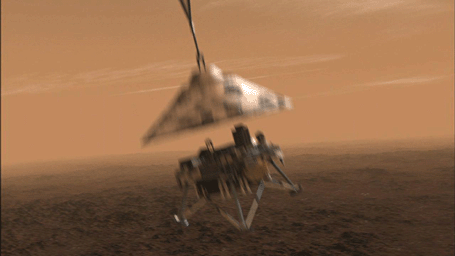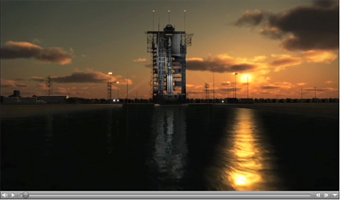
|
Phoenix Without its Parachute
- Click the image above for a larger view
 Movie Download Options
Movie Download Options- Full-Res JPEG (1280 x 720) (56.4 kB)
- Full-Res TIFF (1280 x 720) (2.8 MB)
Caption:

Click on the image for the animation
NASA's Phoenix Mars Lander will be in free fall after it separates from its back shell and parachute, but not for long. Thrusters will begin firing half a second later and will increase their thrusts three seconds after Phoenix sets itself free from the parachute.
The spacecraft will have slowed to about 56 meters per second (125 miles per hour) by the time it separates from the parachute, about a kilometer (six-tenths of a mile) above the ground.
This illustration is part of the animation featured above.
Background Info:
The Phoenix Mission is led by the University of Arizona, Tucson, on behalf of NASA. Project management of the mission is by NASA's Jet Propulsion Laboratory, Pasadena, Calif. Spacecraft development is by Lockheed Martin Space Systems, Denver.
Photojournal Note: As planned, the Phoenix lander, which landed May 25, 2008 23:53 UTC, ended communications in November 2008, about six months after landing, when its solar panels ceased operating in the dark Martian winter.
Cataloging Keywords:
| Name | Value | Additional Values |
|---|---|---|
| Target | Mars | |
| System | ||
| Target Type | Planet | |
| Mission | Phoenix | |
| Instrument Host | Phoenix Lander | |
| Host Type | Lander | |
| Instrument | ||
| Detector | ||
| Extra Keywords | Color, Movie | |
| Acquisition Date | ||
| Release Date | 2008-05-22 | |
| Date in Caption | ||
| Image Credit | NASA/JPL-Caltech/University of Arizona | |
| Source | photojournal.jpl.nasa.gov/catalog/PIA10662 | |
| Identifier | PIA10662 | |
